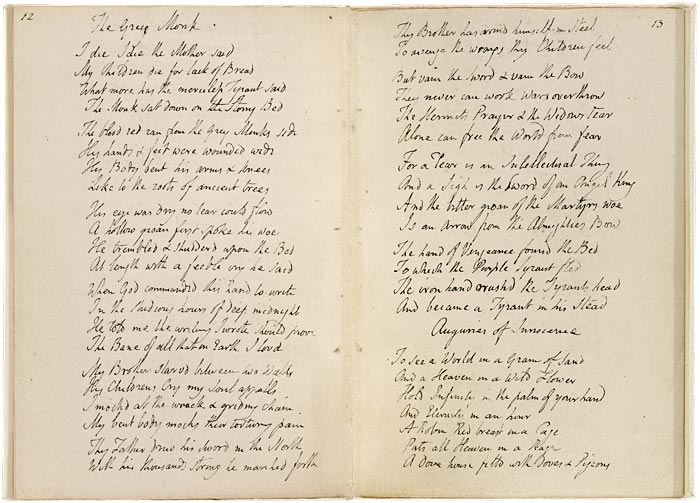
To see a World in a Grain of Sand
And a Heaven in a Wild Flower
Hold Infinity in the palm of your hand
And Eternity in an hour
This volume of ten poems in Blake's hand is the unique source for seven of his poetic works, including "Auguries of Innocence." Some of its other lines illustrate the relationship between public and private acts that destroy the innocence of nature, for example:
A dog starved at his master's gate
Predicts the ruin of the state.
The manuscript is named for a previous owner, B. M. Pickering, who acquired it in 1866 and published it for the first time that year. The poems probably date from about 1801 to 1804. As a "fair copy," it shows that Blake had copied all of the poems into a neat form with few corrections. Based on its paper stock and internal references, the manuscript has been dated to about 1807.
William Blake (1757-1827), The Pickering Manuscript, ca. 1807, pages 12-13 MA 2879
The blood red ran from the Grey Monks side
His hands & feet were wounded wide
His Body bent his arms & knees
Like to the roots of ancient trees
His eye was dry no tear could flow
A hollow groan first spoke his woe
He trembled & shudderd upon the Bed
At length with a feeble cry he said
When God commanded this hand to write
In the studious hours of deep midnight
He told me the writing I wrote should prove
The Bane of all that on Earth I lovd
My Brother starvd between two Walls
His Childrens Cry my Soul appalls
I mockd at the wrack & griding chain
My bent body mocks their torturing pain
Thy Father drew his sword in the North
With his thousands strong he marched forth
Thy Brother has armd himself in Steel
To avenge the wrongs thy Children feel
But vain the Sword & vain the Bow
They never can work Wars overthrow
The Hermits Prayer & the Widows tear
Alone can free the World from fear
For a Tear is an Intellectual Thing
And a Sigh is the Sword of an Angel King
And the bitter groan of the Martyrs woe
Is an Arrow from the Almighties Bow
The hand of Vengeance found the Bed
To which the Purple Tyrant fled
The iron hand crushd the Tyrants head
And became a Tyrant in his stead
Auguries of Innocence
To see a World in a Grain of Sand
And a Heaven in a Wild Flower
Hold Infinity in the palm of your hand
And Eternity in an hour
A Robin Red breast in a Cage
Puts all Heaven in a Rage
A Dove house filld with doves & Pigeons
